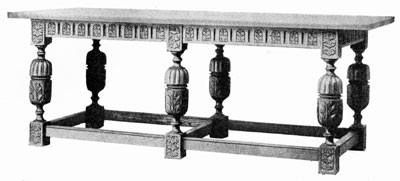Curved Lines within Interior Decorating
Curved lines express the ideas of flexibility, softness, grace and joyousness, and tend to impart these qualities to any composition in which they appear. When over-emphasized by too exclusive employment, as in Rococo ornament and in the decorative styles of the Regency and Louis XV, they yield an effect of over-luxuriousness, instability, and even of weakness. When their lines are short and much broken, as in Rococo ornament, they suggest the mutable and transient; when crossed and interwoven, as in Celtic and Arabic ornament, the complex, obscure and elusive Sinuous or undulating curves, as they appear in the guilloche moulding and in the running vine border of Persian rugs, suggest the idea of movement; and upturned curves, particularly when their effect is intensified by repetition, the ideas of gayety, animation and delight, as the corners of the mouth turn upward in a smile. Wall papers and hangings in which such curves are emphasized are used to help in creating an effect of smiling animation in rooms that need it, and all festal decoration makes a very free use of loops, festoons and swags.
By the free employment of curves the decorator can avoid the stiffness and severity that result from overemphasis of straight lines, and give effects of softness, grace, buoyancy and richness to his rooms. Beauty of form, in nature as in art, from the single leaf to the perfect human body, and from the unadorned simplicity of a vase to the complex loveliness of the Taj Mahal, depends first of all upon the power of curved lines. Moreover, it is impossible in decoration to express the full significance of things that are by nature soft, flexible or luxurious without the free use of curves. Thus velvet draperies look a little stiff when surmounted by straight-lined lambrequins; deep-pile rugs lack something of softness unless they reveal curved lines in either field or border; and the most luxurious of over-stuffed sofas appear bulky, ungraceful and a little stiff unless the long straight lines of their backs are rounded at each end into softening curves.
However, there is no virtue in curves merely as curves. A straight line is always to be preferred, at whatever cost of rigidity and obvious, to a weak and meaningless curve. The decorator cannot hope to create beauty, or even to recognize its presence, until he is able to discriminate unerringly between curves that are graceful, subtle and yet vigorous, and curves awkward, commonplace and unlovely. Much has been written of curves and the laws of curvature, but a feeling for the beauty of curved lines must be acquired through long processes of observation and comparison, and can in fact be acquired in no other way. Nature offers an unlimited field for study. The petals of the rose, iris or honeysuckle, the stems and branches of willow or birch, the leaves of jonquil or cattail or palm- all reveal curves of infinite variety and exquisite grace. The human body, as it is represented in painting and sculpture and in books illustrative of those arts, offers the most perfect examples of composition in curves. Books on architecture and historic furniture, and manuals of ornament and design are also valuable. The materials chosen for study and the methods of using them are relatively unimportant, provided only that they afford the eye such training as will equip it for instant and discriminating judgement.
It is especially important and especially difficult to acquire a sure feeling for beauty and vigour in the curves that define the weight-bearing elements of a composition; for it is to be noted that while horizontal curves may be employed freely and with wide latitude, vertical curves must be designed with great circumspection. Under the law of empathy the mind “feels itself into” the forms defined by curved lines. When these lines are horizontal, as at the back of a davenport, or dependent, as in a lamp shade or at the bottom of a lambrequin-in a word, when they are supported, not supporting-the mind regards almost any pitch or degree of curvature as reasonable and therefore as satisfactory; but when curves are bearing a load the mind expects to find the curvature adjusted to the load, and is dissatisfied and perturbed when this is

PLATE III.- The effect of repose characteristic of this table is due to its length. Its effect of seriousness, dignity, and thoughtful contrivance is due to the emphasis upon long straight lines. The table is in a measure redeemed from austerity by curved line, and enriched by carved ornament.
not the case. For example, in a well-designed eighteenth century table the light top is supported by slender legs having but a slight cyma or line of beauty curve; and this the mind regards as suitable and beautiful because the body of a man bearing upon his shoulder one corner of a light platform would be similarly relaxed into slight but easy curves. Therefore light tables supported by slender legs which describe a deep curve-and these are exceedingly common-have for the trained eye an exaggerate, strained and grotesque appearance, because the sweep of the curves appears to be out of all proportion to the load borne by the legs. On the other hand, the heave tables of the Italian and French Renaissance were supported by end brackets revealing very deep curves, and this the mind regards as reasonable and beautiful because a man likewise heavily burdened would stoop, with his chest bent far forward over his knees. Nowhere in decoration is there more ugliness than in weak, exaggerated and ungraceful vertical curves. Only by long study of both the great and the decadent periods of decorative art can one acquire the power to know good and evil.
 "Finally! Step-by-Step Guidebooks Show
"Finally! Step-by-Step Guidebooks Show